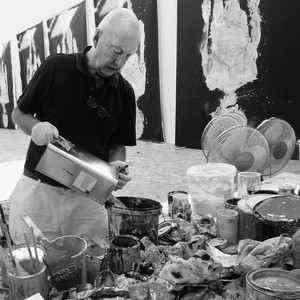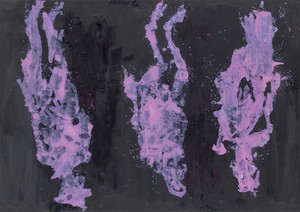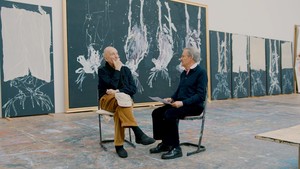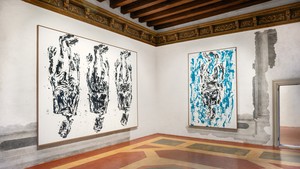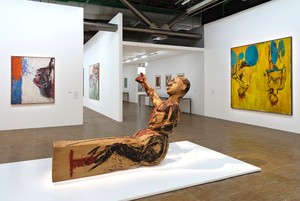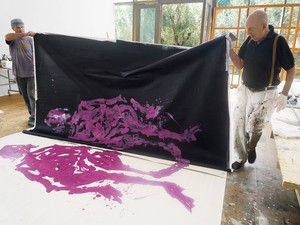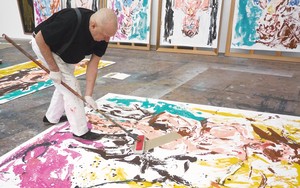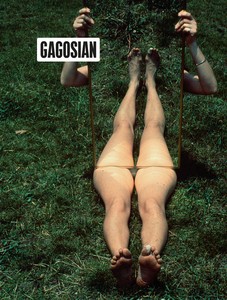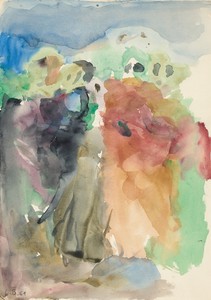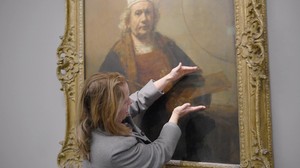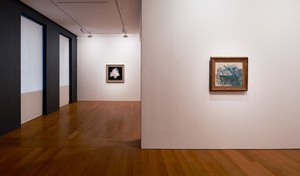Zeng Fanzhi on Georg Baselitz
I first came across Baselitz when I was painting in China during the second half of the 1980s.
During a painting class at university, I saw a student who inverted the figure in his work. The method of expression used—floating the figure at the top of the image—was bursting with visual tension and left me feeling shocked. Later, both from my professors’ resource room and from the publication World Art, to which I subscribed, I learned that this was one of the characteristics of Baselitz’s work. Inversion causes familiar objects to appear unfamiliar and preserves form while also abstracting it. As a student, I found this to be highly stimulating. It demonstrated that art was able to escape from the bonds of reality and obtain the freedom of creative language. It also hinted that traditional portraiture could also be reformed in this way. It’s important to note that at the time, the formalist style promoted by the art academies was that of either Soviet Russian socialist realism or European academic realism. However, I, along with similarly rebellious young artists, wanted to depart from this conservative, singular, mainstream academic aesthetic. We were searching for innovation in, and transformation of, all aspects of painting—from content to form—and from this looking to create an artistic style that would enable us to adequately express our individuality. It was in this ideological desert that Baselitz presented an oasis of opportunity, providing reference for the issues that we were grappling with at that time. As time went on, I paid close attention to avant-garde German art, and became familiar with other German postwar artists. I sensitively came to realize that the motifs of their innovation were underpinned with rebellious spirit and profound thought, and it was precisely these key factors that stimulated the development of art history. Recently, art critics had categorized Baselitz and other artists of his generation as Neo-Expressionists, regarding them as having written a new chapter in postwar art.
Looking back, I recognize that the stimulation we felt was not owing to the visual motifs of the works but was in fact caused by the way in which the German artists of Baselitz’s generation broke new ground, challenging norms and reveling in unbridled self-expression. Not only did their spirit and practice prove inspirational for young artists in faraway China, it also bestowed bravery and strength upon them, encouraging them to broaden their horizons and search for their own artistic trajectories.
More than thirty years later, Baselitz remains active, unrelentingly exhibiting across the globe. For this solo exhibition in Asia, he is showing new works, which, like all his works, are bursting with creativity. Occupying the space between abstract and figurative, his line work is exceptional and his use of color both confident and rich. Baselitz’s portraiture either contains characters themselves or hints at historical memories of the German people, and although he does not drown his works in narrative, there is a strong sense of “existence” in his use of form. From start to finish, he focuses on the existence of the individual, on the reality of humanity and the indescribable pacing of the mind—the same topics that his peers also grappled with. In this way, Baselitz profoundly inspires us, not with the form of his motifs, or his technical skill, but with the way in which he unceasingly focuses on the plight of human existence, revealing a concern for culture that is unique to postwar art, and a social conscience. I sincerely wish Baselitz’s Hong Kong exhibition every success and hope that more Asian viewers are able to gain inspiration and motivation from seeing his works in person. In addition, I hope that the audience will reflect on an artistic career that has both spanned the postwar and contemporary eras and profoundly engaged with history and culture.
Georg Baselitz to Zeng Fanzhi
Dear Zeng Fanzhi,
Oppression comes from outside. Conformism comes from within.
I laughed a lot about contemporary Chinese painting in my youth. But there was also this great history in Chinese art, with Bada Shanren as example.
I had a student friend, his name was Joseph Yu-Kun Yang, who came from Shanghai via Hong Kong to Berlin to study Western painting (Tachism).
His sister studied traditional painting in Hong Kong. There was no such thing in Europe, the old and the new as an artistic interpretation, or as a way of painting. I didn’t think that was an option for me either.
I think we all crossed shaky bridges to reach the present. First, the autocratic systems and dictators troubled us. Then later, and still today, it was and is this submissive conformism that offends me. I know that no one is free, but I’d still like to be.
Your text surprised me. It mentions very open memories of China in your time that I knew nothing about. I know your work, and it always makes me happy to see your paintings. We shall carry on!
The very best of luck and kind regards,
Yours, G.B.

